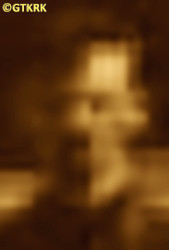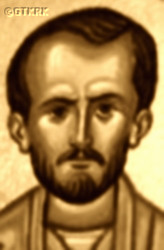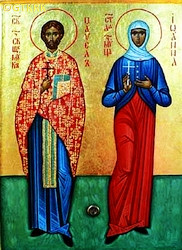Roman Catholic
St Sigismund parish
05-507 Słomczyn
85 Wiślana Str.
Konstancin deanery
Warsaw archdiocese, Poland
full list:
displayClick to display full list

searchClick to search full list by categories
wyświetlKliknij by wyświetlić pełną listę po polsku

szukajKliknij by przeszukać listę wg kategorii po polsku

Martyrology of the clergy — Poland
XX century (1914 – 1989)
personal data
religious status
saint
surname
SZWAJKO
surname
versions/aliases
SZAJKO
forename(s)
Paul (pl. Paweł)

canonisation date
07.06.2003

Saint Council of the Bishops of the Polish Autocephalous Orthodox Churchmore on
en.wikipedia.org
[access: 2019.12.07]
function
presbiter (i.e. iereus)
creed
Eastern Orthodox Church ORmore on
en.wikipedia.org
[access: 2014.09.21]
diocese / province
Chełm‐Podlachia OR eparchy (Autocephalous Orthodox Church in the Generalgouvernement AOC‐GG)more on
pl.wikipedia.org
[access: 2021.08.20]
Warsaw‐Chełm OR eparchy (Polish Autocephalous Orthodox Church PAOC)
date and place
of death
28.08.1943

Grabowiectoday: Grabowiec gm., Zamość pov., Lublin voiv., Poland
more on
en.wikipedia.org
[access: 2021.08.20]
details of death
After German and Russian invasion of Poland in 09.1939 and the beginning of World War II, after the start of the German occupation, beaten by unknown perpetrators in Sniatycze.
Murdered, together with his wife, three Ukrainian SS watchmen (members of the Germ. Wachmannschaften des SS‐ und Polizeiführers in Distrikt Lublin, trained in the Germ. SS‐Ausbildungslager Trawniki i.e. SS training camp Trawniki) and the Ukrainian village leader, by the Polish partisan unit of the Home Army AK (part of the Polish Clandestine State), commanded by Joseph Śmiech ps.
„Spraw” (who, after the end of war hostilities, became a secret agent of the Commie‐Nazi criminal UB organization).
According to Orthodox sources, were to receive several dozen blows with blunt and sharp tools, then was finished off with a firearm, and had an Orthodox cross cut on his chest.
The murder took place during the German «Aktion Zamość», aimed at the displacement of Poles from the Zamość region, during which the Germans pacified the village of Grabowiec, expelling Poles from it, and during the genocide against Poles, called «Genocidium Atrox», carried out by Ukrainians, including the genocidal Ukrainian organization OUN/UPA.
cause of death
mass murder
perpetrators
Poles
sites and events
«Aktion Zamość»Click to display the description, «Genocidium Atrox»Click to display the description, GeneralgouvernementClick to display the description, Ribbentrop‐MolotovClick to display the description
date and place
of birth
04.04.1893

Zabolottsitoday: Zabolottsi hrom., Zolochiv rai., Lviv obl., Ukraine
more on
en.wikipedia.org
[access: 2021.08.20]
parents
SZWAJKO Conrad
🞲 ?, ? — 🕆 ?, ?

Eve
🞲 ?, ? — 🕆 ?, ?
presbyter (holy orders)
ordination
21.09.1924

positions held
from 05.04.1943
parish priest — Grabowiectoday: Grabowiec gm., Zamość pov., Lublin voiv., Poland
more on
en.wikipedia.org
[access: 2021.08.20] ⋄ Dormition of the Blessed Virgin Mary OR church — after the building of the Roman Catholic church was taken and handed over to the Orthodox church by the Germans (after the start of the German occupation in 1941)
28.12.1942
protoiereus (Eng. first priest) — Autocephalous Orthodox Church in the Generalgouvernement AOC‐GG — dignity conferment
c. 1942 – c. 1943
parish priest — Śniatyczetoday: Komarów‐Osada gm., Zamość pov., Lublin voiv., Poland
more on
en.wikipedia.org
[access: 2023.07.16] ⋄ St John the Baptist OR church ⋄ Tomaszów Lubelskitoday: Tomaszów Lubelski gm., Tomaszów Lubelski pov., Lublin voiv., Poland
more on
en.wikipedia.org
[access: 2021.08.20] OR deanery — after the building of the Roman Catholic church was taken and handed over to the Orthodox church by the Germans (after the start of the German occupation in 1941)
c. 1942
parish priest — Obszatoday: Obsza gm., Biłgoraj pov., Lublin voiv., Poland
more on
en.wikipedia.org
[access: 2020.09.24] ⋄ Dormition of the Blessed Virgin Mary OR church — after the building of the Roman Catholic church was taken and handed over to the Orthodox church by the Germans (after the start of the German occupation in 1941)
from 10.02.1939
parish priest — Siedliskatoday: Lubycza Królewska gm., Tomaszów Lubelski pov., Lublin voiv., Poland
more on
en.wikipedia.org
[access: 2023.07.16] ⋄ St Nicholas OR parish ⋄ Tomaszów Lubelskitoday: Tomaszów Lubelski gm., Tomaszów Lubelski pov., Lublin voiv., Poland
more on
en.wikipedia.org
[access: 2021.08.20] OR deanery
till c. 1939
curatus/rector/expositus — Desznicatoday: Nowy Żmigród gm., Jasło pov., Subcarpathia voiv., Poland
more on
en.wikipedia.org
[access: 2022.01.22] ⋄ St Demetrius the Martyr OR church (fillial) — ministry during the so‐called the „Tylava schism”, i.e. the conversion in 1926‐1934 of a number of Lemko villages and Greek Catholic parishes to Orthodoxy; resident of a newly built church; missionary activities, i.a. in 1931 teaching the Orthodox religion in the village of Kotań
c. 29.08.1934
priest — Hai‐Levyatynskitoday: Radyvyliv urban hrom., Dubno rai., Rivne obl., Ukraine
more on
uk.wikipedia.org
[access: 2024.03.15] ⋄ St Nicholas OR parish — wife's place of birth
from 15.10.1927
priest — Świątkowa Małatoday: Krempna gm., Jasło pov., Subcarpathia voiv., Poland
more on
en.wikipedia.org
[access: 2024.03.15] ⋄ OR chapel — sent by Metropolitan Dyonisius Waledyński, in connection with the so‐called the „Tylavian schism”, i.e. the wave of conversions of Lemkos from Greek Catholicism to Orthodoxy in the years 1926‐1934; deprived, however, of the use of the church buildings — both St Michael the Archangel churches in the neighboring villages of Świątkowa Mała and Świątkowa Wielka— which, under the concordat between Poland and the Holy See in the Vatican, remained as a Catholic temple in the hands of the remaining Greek Catholic community
from 15.10.1927
priest — Świerzowa Ruskatoday: Krempna gm., Jasło pov., Subcarpathia voiv., Poland
more on
en.wikipedia.org
[access: 2024.03.15] ⋄ OR chapel — sent by Metropolitan Dyonisius Waledyński, in connection with the so‐called the „Tylavian schism”, i.e. the wave of conversions of Lemkos from Greek Catholicism to Orthodoxy in the years 1926‐1934
1924 – 1927
parish priest — Potok Górnyform.: Potok Ordynacki
today: Potok Górny gm., Biłgoraj pov., Lublin voiv., Poland
more on
en.wikipedia.org
[access: 2021.08.20] ⋄ Nativity of the Blessed Virgin Mary OR church — appointment: on 13.08.1924, the building of the church was closed by the Polish authorities; also: delegate to the School Council of Potok district
21.09.1924
presbiter (Eng. priest, i.e. iereus) — Polish Autocephalous Orthodox Church PACP — priesthood cheirotonia, i.e. ordination, on 14.09.1924 preceded by deacon cheirotonia
c. 1924
aspirant — Warsawtoday: Warsaw city pov., Masovia voiv., Poland
more on
en.wikipedia.org
[access: 2021.10.09] ⋄ Holy Trinity OR cathedral church — formation stage
till 1918
student — Yekaterinoslavtoday: Dnipro, Dnipro urban hrom., Dnipro rai., Dnipropetrovsk obl., Ukraine
more on
en.wikipedia.org
[access: 2020.11.27] ⋄ philosophy and theology, Orthodox Theological Seminary
from 1923
married
others related
in death
BAZYLUKClick to display biography James (monk Ignatius), HOLCClick to display biography Nicholas, KOROBCZUKClick to display biography Leo, MARTYSZClick to display biography Basil, OHRYZKOClick to display biography Peter, PERADZEClick to display biography Gregory (Fr Gregory), ZACHARCZUKClick to display biography Sergius
sites and events
descriptions
«Aktion Zamość»: On 11.1942, the Germans began «Aktion Zamość» — a series of forced resettlement, an ethnic cleansing actions of the Polish population and pacification of Polish villages carried out in the Zamość region, in the territory of the Germ. Generalgouvernement (Eng. General Governorate) occupied by Germans, under the Germ. Generalplan Ost GPO (Eng. General Plan East), i.e. the plan of German settlement and Germanization of territories in Central and Eastern Europe. Until 08.1943, it covered a total of 100,000‐110,000 displaced Poles, including 30,000 children (some of them were taken from their parents and semt for a forced Germanization in German families) — most of them passed through the special Germ. UWZ Lager Zamość (Eng. resettlement camp in Zamość), where selection took place, e.g. group IV, children separated from parents. In place of the displaced, it was intended to settle 60,000 German colonists from Bessarabia, Ukraine, Bosnia, Serbia, Slovenia and Russia. In the first phase (28.11.1942‐03.1943) 116 villages were forcibly displaced — the displacements were carried out by Germ. Schutzpolizei units or the gendarmerie, with the help of the Ukrainian Auxiliary Police collaborating with Germany; in the second, as part of the so‐called Aktion Werwolf (06.1943‐08.1943) — 171 villages — the displacements were supervised by Wehrmacht and Waffen‐SS units, supported by the employees of UWZ Lager Zamość. As a result of the actions of the Polish resistance movement — during the so‐called Zamość Uprising, Polish partisans fought several large battles with the overwhelming German forces — 293 villages were displaced out of the 696 planned. In some villages Germans settled resettled Ukrainians — during the so‐called Ukraineraktion — under control of collaborating with Germans Ukrainian Support Committees among others. (more on: en.wikipedia.orgClick to attempt to display webpage
[access: 2021.08.20], journals.umcs.plClick to attempt to display webpage
[access: 2021.08.20])
«Genocidium Atrox»: In 1939‐1947, especially in 1943‐1944, independent Ukrainian units, mainly belonging to genocidal Ukrainian organizations OUN (political arm) and UPA (military arm), supported by local Ukrainian population, murdered — often in extremely brutal way — in Volyn and surrounding regions of pre‐war Poland, from 130,000 to 180,000 Poles, all civilians: men, women, children, old and young. Polish‐Ukrainian conflict that openly emerged during and after World War I (in particular resulting in Polish‐Ukrainian war of 1918‐1919), that survived and even deepened later when western Ukraine became a part Poland, exploded again after the outbreak of the World War II in 09.1939. During Russian occupation of 1939‐1941, when hundreds of thousands of Poles were deported into central Russia, when tens of thousands were murdered (during so‐called Katyń massacres, among others), this open conflict had a limited character, helped by the fact that at that time Ukrainians, Ukrainian nationalists in particular, were also persecuted by the Russians. The worst came after German‐Russian war started on 22.06.1941 and German occupation resulted. Initially Ukrainians supported Germans (Ukrainian police was initiated, Ukrainians co—participated in extermination of the Jews and were joining army units fighting alongside Germans). Later when German ambivalent position towards Ukraine became apparent Ukrainians started acting independently. And in 1943 one of the units of aforementioned Ukrainian OUN/UPA organization, in Volyn, started and perpetrated a genocide of Polish population of this region. In mere few weeks OUN/UPA murdered, with Germans passively watching on the sidelines, more than 40,000 Poles. This strategy was consequently approved and adopted by all OUN/UPA organisations and similar genocides took place in Eastern Lesser Poland (part of Ukraine) where more than 20,000 Poles were slaughtered, meeting however with growing resistance from Polish population. Further west, in Chełm, Rzeszów, etc. regions this genocide turned into an extremely bloody conflict. In general genocide, perpetrated by Ukrainian nationalists, partly collaborating with German occupants, on vulnerable Polish population took part in hundreds of villages and small towns, where virtually all Polish inhabitants were wiped out. More than 200 priests, religious and nuns perished in this holocaust — known as «Genocidium Atrox» (Eng. „savage genocide”) The nature and purpose of genocide is perhaps best reflected in the song sung by the murderers: „We will slaughter the Poles, we will cut down the Jews, we must conquer the great Ukraine” (ukr. „Поляків виріжем, Євреїв видусим, велику Україну здобути мусим”). This holocaust and conflict ended up in total elimination of Polish population and Polish culture from Ukraine, in enforced deportations in 1944‐1945 of remaining Poles from Ukraine and some Ukrainians into Ukraine proper, and finally in deportation of Ukrainians from East‐South to the Western parts of Polish republic prl by Commie‐Nazi Russian controlled Polish security forces („Vistula Action”). (more on: www.swzygmunt.knc.plClick to attempt to display webpage
[access: 2021.06.20])
Generalgouvernement: After the Polish defeat in the 09.1939 campaign, which was the result of the Ribbentrop‐Molotov Pact and constituted the first stage of World War II, and the beginning of German occupation in part of Poland (in the other, eastern part of Poland, the Russian occupation began), the Germans divided the occupied Polish territory into five main regions. In two of them new German provinces were created, two other were incorporated into other provinces. However, the fifth part was treated separately, and in a political sense it was supposed to recreate the German idea from 1915 (during World War I, after the defeat of the Russians in the Battle of Gorlice in 05.1915) of creating a Polish enclave within Germany. Illegal in the sense of international law, i.e. Hague Convention, and public law, managed by the Germans according to separate laws — especially established for the Polish Germ. Untermenschen (Eng. subhumans) — till the Russian offensive in 1945 it constituted part of the Germ. Großdeutschland (Eng. Greater Germany). Till 31.07.1940 formally called Germ. Generalgouvernement für die besetzten polnischen Gebiete (Eng. General Government for the occupied Polish lands) — later simply Germ. Generalgouvernement (Eng. General Governorate), as in the years 1915‐1918. From 07.1941, i.e. after the German attack on 22.06.1941 against the erstwhile ally, the Russians, it also included the Galicia district, i.e. the Polish pre‐war south‐eastern voivodeships. A special criminal law was enacted and applied to Poles and Jews, allowing for the arbitrary administration of the death penalty regardless of the age of the „perpetrator”, and sanctioning the use of collective responsibility. After the end of the military conflict of the World War UU, the government of the Germ. Generalgouvernement was recognized as a criminal organization, and its leader, governor Hans Frank, guilty of war crimes and crimes against humanity and executed. (more on: en.wikipedia.orgClick to attempt to display webpage
[access: 2024.12.13])
Ribbentrop‐Molotov: Genocidal Russian‐German alliance pact between Russian leader Joseph Stalin and German leader Adolf Hitler signed on 23.08.1939 in Moscow by respective foreign ministers, Mr. Vyacheslav Molotov for Russia and Joachim von Ribbentrop for Germany. The pact sanctioned and was the direct cause of joint Russian and German invasion of Poland and the outbreak of the World War II in 09.1939. In a political sense, the pact was an attempt to restore the status quo ante before 1914, with one exception, namely the „commercial” exchange of the so‐called „Kingdom of Poland”, which in 1914 was part of the Russian Empire, fore Eastern Galicia (today's western Ukraine), in 1914 belonging to the Austro‐Hungarian Empire. Galicia, including Lviv, was to be taken over by the Russians, the „Kingdom of Poland” — under the name of the General Governorate — Germany. The resultant „war was one of the greatest calamities and dramas of humanity in history, for two atheistic and anti‐Christian ideologies — national and international socialism — rejected God and His fifth Decalogue commandment: Thou shall not kill!” (Abp Stanislav Gądecki, 01.09.2019). The decisions taken — backed up by the betrayal of the formal allies of Poland, France and Germany, which on 12.09.1939, at a joint conference in Abbeville, decided not to provide aid to attacked Poland and not to take military action against Germany (a clear breach of treaty obligations with Poland) — were on 28.09.1939 slightly altered and made more precise when a treaty on „German‐Russian boundaries and friendship” was agreed by the same murderous signatories. One of its findings was establishment of spheres of influence in Central and Eastern Europe and in consequence IV partition of Poland. In one of its secret annexes agreed, that: „the Signatories will not tolerate on its respective territories any Polish propaganda that affects the territory of the other Side. On their respective territories they will suppress all such propaganda and inform each other of the measures taken to accomplish it”. The agreements resulted in a series of meeting between two genocidal organization representing both sides — German Gestapo and Russian NKVD when coordination of efforts to exterminate Polish intelligentsia and Polish leading classes (in Germany called «Intelligenzaktion», in Russia took the form of Katyń massacres) where discussed. Resulted in deaths of hundreds of thousands of Polish intelligentsia, including thousands of priests presented here, and tens of millions of ordinary people,. The results of this Russian‐German pact lasted till 1989 and are still in evidence even today. (more on: en.wikipedia.orgClick to attempt to display webpage
[access: 2015.09.30])
sources
personal:
prasa.wiara.plClick to attempt to display webpage
[access: 2013.05.19], pl.wikipedia.orgClick to attempt to display webpage
[access: 2013.05.19], www.impantokratoros.grClick to attempt to display webpage
[access: 2013.05.19]
bibliographical:
„Hierachy, clergy and employees of the Orthodox Church in the 19th‐21st centuries within the borders of the Second Polish Republic and post–war Poland”, Fr Gregory Sosna, M. Antonine Troc-Sosna, Warsaw–Bielsk Podlaski 2017
original images:
cerkiewne.tematy.netClick to attempt to display webpage
[access: 2023.07.16], www.impantokratoros.grClick to attempt to display webpage
[access: 2013.05.19], sklep.cerkiew.plClick to attempt to display webpage
[access: 2021.08.20]
LETTER to CUSTODIAN/ADMINISTRATOR
If you have an Email client on your communicator/computer — such as Mozilla Thunderbird, Windows Mail or Microsoft Outlook, described at WikipediaPatrz:
en.wikipedia.org, among others — try the link below, please:
LETTER to CUSTODIAN/ADMINISTRATORClick and try to call your own Email client
If however you do not run such a client or the above link is not active please send an email to the Custodian/Administrator using your account — in your customary email/correspondence engine — at the following address:

giving the following as the subject:
MARTYROLOGY: SZWAJKO Paul
To return to the biography press below:
 Click to return to biography
Click to return to biography










